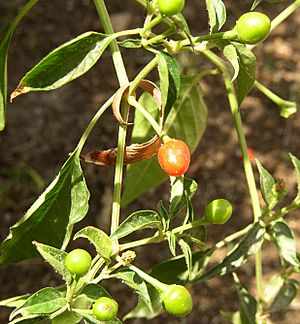Chiltepín facts for kids
Quick facts for kids Capsicum annuum var. glabriusculum |
|
|---|---|
 |
|
| Scientific classification |
|
| Kingdom: | Plantae |
| Clade: | Tracheophytes |
| Clade: | Angiosperms |
| Clade: | Eudicots |
| Clade: | Asterids |
| Order: | Solanales |
| Family: | Solanaceae |
| Genus: | Capsicum |
| Species: | |
| Varietas: |
C. a. var. glabriusculum
|
| Trinomial name | |
| Capsicum annuum var. glabriusculum (Dunal) Heiser and Pickersgill
|
|
| Synonyms | |
|
|
| Chiltepín | |
|---|---|
| Heat | |
| Scoville scale | 50,000–1,628,000 SHU |
Capsicum annuum var. glabriusculum is a variety of Capsicum annuum that is native to southern North America and northern South America. Common names include chiltepin, Indian pepper, chiltepe, and chile tepin, as well as turkey, bird’s eye, or simply bird peppers, due to their consumption and spread by wild birds. Tepin is derived from a Nahuatl word meaning "flea". This variety is the most likely progenitor of the domesticated C. annuum var. annuum. Another similar-sized pepper 'Pequin' (also called 'piquin') is often confused. The tepin fruit is round to oval and the pequin is oval with a point, and the leaves, stems and plant structures are very different on each plant.
Description
Chiltepin is a perennial shrub that usually grows to a height of around 1 m (3.3 ft), but sometimes reaches 3 m (9.8 ft). and in areas without hard frost in winter, plants can live 35–50 years.
Fruit
The tiny chili peppers of C. a. var. glabriusculum are red to orange-red, usually slightly ellipsoidal, and about 0.8 cm (0.31 in) in diameter. Some strains of tepin peppers are much closer to perfectly round when fresh. If a tepin pepper is dried, it appears quite round even if it was slightly ellipsoidal when fresh. Tepin peppers are very hot, measuring between 50,000 and 1,628,000 Scoville units.
The tepin can be hotter than the habanero or red savina, with the highest levels seen in green fruit 40-50 days after fruit set.
However, since this pepper is harvested from wild stands in the Mexican desert, the heat level of the fruit can vary greatly from year to year, depending on the amount of natural rainfall that occurs during the time the fruits are forming. During drought years, fruit heat levels can be weak, and during normal rainfall years, the highest heat levels are produced. Also there is a large variation between the heat levels of the green fresh fruit (which are pickled in vinegar), red-ripe fresh fruit, dried whole fruit and dried fruit with the seeds removed, and their heat levels are arranged from mildest to hottest in that order. Around 50 tons are estimated to be harvested commercially annually in Mexico, primarily in Sonora.
In Mexico, the heat of the chiltepin is called arrebatado ("rapid" or "violent"), because, while the heat is intense, it is not very enduring. This stands in contrast to the domesticated 'Pequin' variety, which is the same size as the wild tepin, but is oval-shaped, and delivers a decidedly different experience.
The different drying methods used for the tepin and 'Pequin', can help tell these peppers apart. Tepins are always sun-dried, whereas the Pequins are commonly dried over wood smoke, and the smell of the smoke in the Pequins can help separate the two varieties. Pequins are not as hot as chiltepins (only about 30,000–50,000 Scoville units), but they have a much slower and longer-lasting effect.
Habitat and range
C. a. var. glabriusculum can be found in Texas, Arizona, and Florida in the Southern United States, the Bahamas, the Caribbean, Mexico, Central America, and Colombia. It prefers well-drained soils, such as silty or sandy loams, and 800–2,000 mm (31–79 in) of annual precipitation in Puerto Rico. It may be found in areas with a broken forest canopy or disturbed areas that lack tree cover if moisture and soil are favorable. Elsewhere, such as in Arizona, it may require the partial shading of a nurse plant.
Symbolism
Chiltepin was named "the official native pepper of Texas" in 1997, two years after the jalapeño became the official pepper of Texas.
Conservation
In 1999, Native Seeds/SEARCH and the United States Forest Service established the 2,500-acre (1,000 ha) Wild Chile Botanical Area in the Coronado National Forest. Located in the Rock Corral Canyon near Tumacacori, Arizona, the preserve protects a large C. a. var. glabriusculum population for study and as a genetic reserve.
See also
 In Spanish: Chiltepín para niños
In Spanish: Chiltepín para niños



